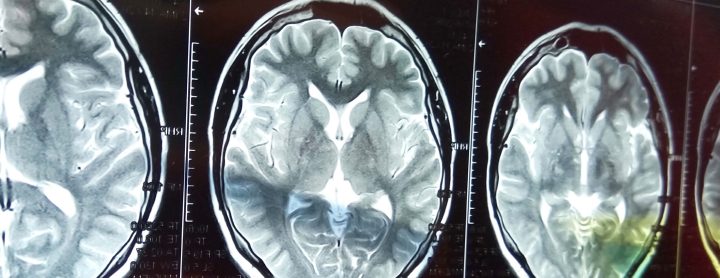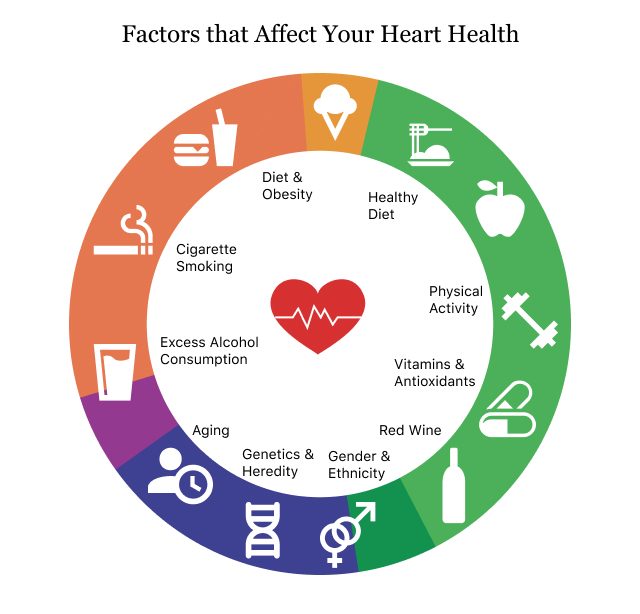Cardiovascular Health
Cardiovascular health applies to the health of your heart and all your blood vessels. While cardiovascular conditions may be inherited, many of its risk factors are either preventable or controllable. These include smoking or other tobacco use, high blood pressure, high cholesterol and diabetes.

Cardiovascular disease, also called heart disease, incorporates several kinds of conditions that may be influenced by heart and blood vessel conditions.
The most common cardiovascular condition in the United States is coronary artery disease (CAD), also called coronary heart disease or ischemic heart disease. It’s caused by a buildup of plaque on the walls of the arteries. Plaque is made of cholesterol and other substances. As they build up over time, they can narrow the passageways in your arteries. This can reduce or completely stop the flow of blood through a blood vessel. This condition is called atherosclerosis.
This can lead to a heart attack, which is often the first sign that a person has CAD.

Heart Disease
Heart disease is the leading cause of death for all adults in the United States, responsible for one in every 4 deaths. It kills 647,000 Americans every year — about one person every 37 seconds — according to the U.S. Centers for Disease Control and Prevention. Preventing or controlling heart disease is one of the most important health measures Americans can take to improve their life expectancy.
- Coronary artery disease
- Heart attack
- Arrhythmia
- Heart failure
Source: U.S. Centers of Disease Control and Prevention
Heart disease can frequently be “silent” — meaning it can develop over years before you know you have it. The first sign of heart disease might be a heart attack.
People should check the warnings on any medications they take to find out what the cardiovascular health risks for the drug may be.
- Rosiglitazone
- Marketed as Avandia and prescribed to treat type 2 diabetes, it carries a black box warning on its label about increased risk of congestive heart failure, stroke and heart attack
- Rofecoxib
- Sold as Vioxx and used to treat arthritis, acute pain and migraine headaches, its manufacturer pulled it off the market after a study found 2.4 percent of patients in a clinical trial suffered heart attacks, angina or sudden death compared to only 1 percent who did not take Vioxx.
- Omalizumab
- Marketed in the U.S. as Xolair and used to treat severe, persistent allergic asthma and chronic hives, carries a warning on its label that it can cause inflammation of blood vessels in people with certain health conditions. The inflammation, in rare cases, can cause vessels to burst.

Heart Attack
Heart attacks happen when part of the heart doesn’t get enough blood. These are medical emergencies that require immediate attention. The longer the heart goes without proper blood flow, the greater the damage to the heart.
A heart attack happens every 40 seconds in the United States according to the CDC. Americans suffer about 805,000 heart attacks every year. For 200,000 of those, it’s not their first heart attack.
Heart attacks may be accompanied by excruciating pain in the upper body or a person may not feel anything. About one in every five heart attacks is silent. In those cases, the attack has damaged the heart but the person isn’t even aware it happened.
- Chest pain or discomfort in the center or left side of the chest, lasting several minutes or stopping and starting again. It may feel like squeezing, fullness in the chest, uncomfortable pressure or pain
- Pain or discomfort in the back, neck or jaw
- Shortness of breath which may occur before or during chest discomfort
- Feeling weak, lightheaded, or faint, sometimes accompanied by cold sweats
- Shoulder and arm pain or discomfort that may be on either side of the body or on both sides at the same time
Source: U.S. Centers for Disease Control and Prevention
Other symptoms that may accompany a heart attack include indigestion, heartburn, extreme fatigue and nausea or vomiting.
Anyone experiencing the five major symptoms of a heart attack should call 911 immediately. Swift medical attention can improve your chances of survival and long-term recovery.

Heart Failure
Heart failure, or congestive heart failure, is a serious condition that happens when your heart can’t pump enough blood to carry needed oxygen to your other organs. But it doesn’t mean your heart has completely stopped beating or that it is about to stop working altogether.
A weakened heart reduces its pumping capacity. That means blood and fluid can back up into the lungs, fluid can build up in the legs, ankles and feet causing swelling there and it can result in tiredness and shortness of breath.
- Feeling tired or weak much of the time
- Shortness of breath when performing routine activities
- Trouble breathing when you lie down
- Weight gain coupled with swelling in your legs, feet, ankles or stomach
Source: U.S. Centers for Disease Control and Prevention
Heart failure affects about 6.5 million adults and is a contributing cause of one in every eight deaths in the United States, according to the CDC.
- Coronary heart disease
- Diabetes
- High blood pressure
- Obesity
- Valvular heart disease
- Smoking or other tobacco use
- Diet high in fats, cholesterol or sodium
- Physical inactivity
- Excessive alcohol use
Source: U.S. Centers for Disease Control and Prevention
The 4 Stages of Heart Failure
There are four stages of heart failure, ranked in progressively increasing severity from A through D. Each time your stage advances, your chances of living for another five years decreases.
STAGE A HEART FAILURE
In Stage A, people experience no dysfunction of the heart’s pumping action, but they have health conditions that may lead to developing heart failure. These conditions include high blood pressure, coronary artery disease and diabetes. People with Stage A heart failure may not experience symptoms of heart failure but will experience symptoms of the underlying conditions.
STAGE B HEART FAILURE
People with Stage B heart failure will experience their first heart problems, but they may not show any symptoms. The heart may slow its pumping ability leading to portions of the heart becoming enlarged. This condition may also happen to people who’ve suffered a heart attack.
STAGE C HEART FAILURE
Some people with Stage C heart failure will start exhibiting signs of heart failure as the pumping chamber of the heart begins to have problems. These symptoms include shortness of breath and fatigue. Others may show no symptoms of Stage C heart failure but are being treated for previous heart-related symptoms.
STAGE D HEART FAILURE
Stage D heart failure is a severe condition requiring advanced and specialized care including mechanical support to keep the heart pumping, a heart transplant or even hospice care. People at Stage D experience significant heart failure symptoms even when they are at rest.

Stroke
A stroke happens when blood flow to the brain is interrupted or stopped. Brain cells start to die within just a few minutes if they are deprived of the oxygen and nutrients that the blood delivers to them. This can result in brain damage, long-term disability and death.
Strokes are a medical emergency and if you or someone else is having one, you should call 911 immediately. Quick medical attention can save your life and shorten your recovery time.
- Numbness on one side of your body or in the face, arm or leg
- Confusion and difficulty speaking or understanding other people talking to you
- Trouble seeing in one or both eyes
- Difficulty walking, lack of coordination, dizziness or loss of balance
- Severe headache with no known cause
Source: U.S. Centers for Disease Control and Prevention
Stroke is the fifth leading cause of death and a leading cause of serious disability in the United States. About 795,000 Americans suffer strokes every year according to the CDC. But it is both preventable and treatable.

Heart Arrhythmia
Arrhythmia is a condition in which your heart beats too fast, too slow or at an irregular rhythm. Atrial fibrillation, or AF, is the most common type of arrhythmia.
An electrical system in the heart allows it to beat and controls its rhythm. Arrhythmias happen when there’s a problem with that electrical system.
- Chest pain
- Fast or slow heart beats
- Heart skipping beats
- Lightheadedness
- Dizziness
- Shortness of breath
- Sweating
Source: U.S. National Library of Medicine
There are several causes of heart arrhythmias. A previous heart attack, congenital heart defects, smoking and stress can cause them.
They can be treated with medicines, a device called an implantable cardioverter-defibrillator (ICD) or a pacemaker. Surgery may also restore a normal heartbeat.

Addressing Risks to Cardiovascular Health
Most types of heart disease share common causes. About 47% of all Americans have one of the three leading risk factors for heart disease — smoking, high blood pressure and high cholesterol. But there are several other factors that can increase your risk for developing heart disease.
- Smoking
- High blood pressure
- High cholesterol
- Diabetes
- Being overweight or obese
- Eating an unhealthy diet
- Physical inactivity
- Excessive alcohol use
Source: U.S. Centers for Disease Control and Prevention

Steps to Protect Cardio Health
Diet and exercise are among the most important steps to prevent heart disease. Keeping conditions like diabetes, cholesterol and diabetes under control can also reduce cardiovascular health risks. Quitting tobacco can also greatly reduce your risks.
- High fiber foods
- Foods low in saturated fats, trans fats and cholesterol
- Limit salt (sodium)
- Limit sugar
- Drink alcohol in moderation – no more than two drinks per day for men, 1 drink per day for women
Controlling your weight is important for preventing cardiovascular disease. Extra weight puts extra stress on your heart and blood vessels. But diet alone will not control your weight. The U.S Surgeon General recommends at least two hours and 30 minutes of moderate-intensity exercise every week. These activities include bicycling, jogging or brisk walking.
You should also talk with your doctor or other health care provider about managing underlying conditions that improve your cardiovascular health. This includes taking your medications as directed and controlling cholesterol, lowering your blood pressure, and managing your diabetes.
Calling this number connects you with a Drugwatch.com representative. We will direct you to one of our trusted legal partners for a free case review.
Drugwatch.com's trusted legal partners support the organization's mission to keep people safe from dangerous drugs and medical devices. For more information, visit our partners page.

